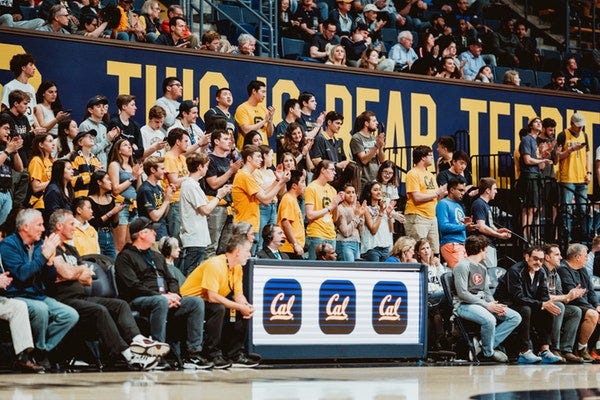Cal Men's Basketball Season In Review, Part 2: What went wrong?
The Bears improved, but there's still a long way to go before a return to the days of Pac-12 title and NCAA tournament contention

Photo credit: CalBears.com
Last week, we looked at what went right in the 2019-20 season. And to win 6 more games (and 5 more games against Pac-12 teams) something indeed had to go right. But the Bears were still a meaningfully below average Pac-12 team, and there are still clearly a number of areas in which Cal needs to improve if they want to start pushing toward thinking about post-season play again. So let’s talk about what didn’t go right.
Cal couldn’t hit 2 point shots
If you wanted to concisely encapsulate Cal’s offensive struggles, this would be the best single stat to point to. As much as the 3 point shot has grown as a massive weapon, for most offenses hitting 2 point shots is still the life-blood of an offense.
The Bears finished 320th in the nation in 2 point shooting percentage at 45.5%. That mark was tied with Pittsburgh for worst 2 point shooting percentage in major conference basketball.
A lot of these struggles stem from the frequency with which Cal takes low-efficiency 2 point jump shots, but I’m not going to belabor that point more. Suffice to say that Cal would benefit from finding schemes, plays, and players who can create better 2 point scoring opportunities.
It is worth noting that Cal was below average at finishing the relatively rare shots at the rim that they did earn. Of players who took enough shots to constitute a solid sample, Andre Kelley was the only player who finished at an above average rate, and Matt Bradley and Grant Anticevich were the only players who finished at a roughly average rate.
Much of this was, to a certain extent, a conscious trade off. When you voluntarily elect to slow the ball down, that means sacrificing potential transition opportunities or perhaps average shot opportunities in favor of burning clock, with no guarantee that a good shot will still be there when the shot clock is in the single digits. Once basketball is back, I’ll be particularly interested to see if and when Mark Fox decides to let loose on the reins and let the Bears play at something closer to an average pace.
Three point defense
Cal’s opponents shot really well from 3 against the Bears all season long. 36.3%, to be precise, which ranked 310th in the nation. This is certainly an anomaly for a Mark Fox coached team: In 14 prior seasons as a head coach, only twice had Fox’s teams allowed their opponents to shoot threes above the national average.
Of course, defenses generally only have a very limited amount of control over how well their opponents make their 3 point shots. A year ago, when I looked at Mark Fox’s statistical history, I wrote this:
Worth noting: Fox’s teams have not shown a consistent ability to suppress 3 point shot attempts from their opponents, while simultaneously putting up above average 3pt% defense. Might Mark Fox be one of the rare coaching unicorns with a defense that somehow exerts more control over 3 point shooting percentage than average? I’m doubtful but open to being wrong.
Well, for one year at least, Cal allowed their opponents to take lots of three point attempts . . . and they made them at a high rate. Maybe that’s a one year anomaly, and once Fox fully teaches his defense his charges will go right back to forcing a lower percentage. Maybe this is a decade’s worth of mean-reversion. Maybe it’s statistical noise. Either way, it’s something Cal must improve upon if they’re going to play defense the way Mark Fox wants them to play defense.
Cal’s freshman class struggled to make an impact, particularly on offense
This is probably the most relevant concern for next year. Three of Cal’s five freshmen received infrequent, inconsistent minutes, and four of Cal’s five freshmen posted below average offensive ratings. In short - Cal’s five player freshman class didn’t make a big impact in year 1, which makes the forecast for next season much hazier.
That doesn’t mean you can’t find reasons for optimism. Joel Brown clearly has above average Pac-12 speed and at least average Pac-12 athleticism. Lars Thiemann is still seven feet tall and can move well enough that more development can turn him into a valuable player. Kuany Kuany actually looked like a pretty solid 3-and-D guy. D.J. Thorpe, like so many raw post players, will be a solid player once he limits his turnovers and improves his ability to contest shots without fouling.
The challenge is that if Cal wants to meaningfully improve on this season, one obvious way is for the freshmen to take 2nd year leaps. And while I expect all of them to improve significantly as defenders, there are enough gaps offensively that I’m not sure Cal can raise their offensive ceiling without Matt Bradley doing some kind of James-Harden-at-ASU impression. Which, to be clear, would be awesome and I wholeheartedly encourage.
OK, with what when right and wrong out of the way, we’re going to move on towards looking at recruiting and trying to guess at how much better the Bears could get next season. It is safe to assume that they will be better next year, right?


Hopefully the new recruits - Bowser, Celestine will make an impact. Kuany as a first year player showed some long-armed defensive chops as well as an ability to make timely threes. Thorpe looked solid at times. Clearly though we can't miss short-range shots like we did this season. How many layups did we miss? An awful lot, as well.